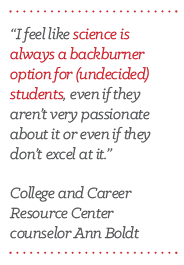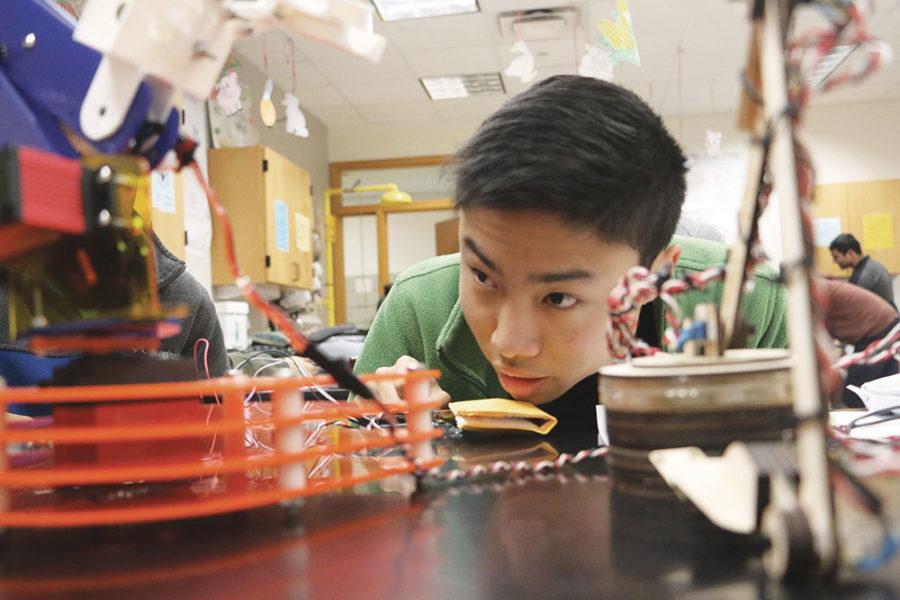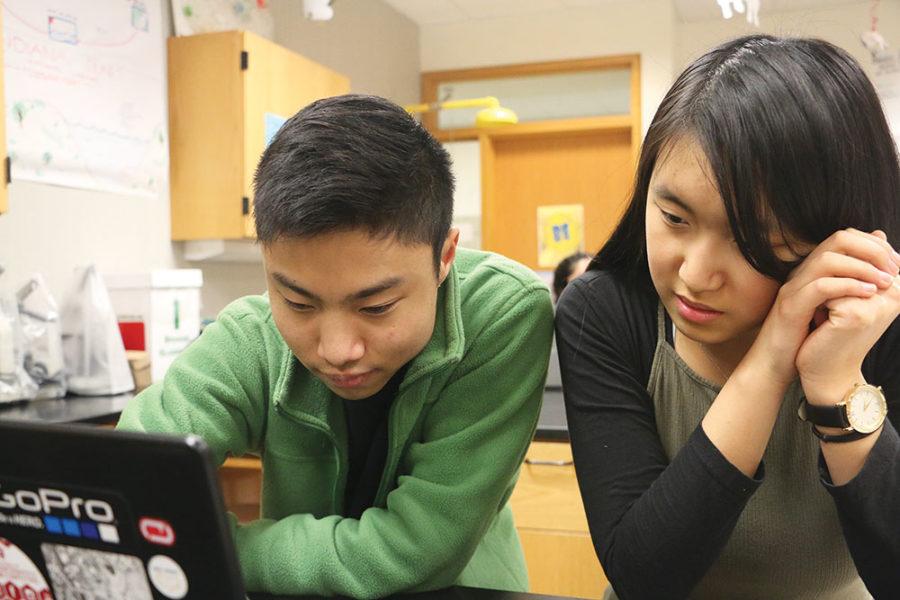Meet senior Darren Chang. For the past three summers, Chang has worked eight to 10 hours a day for five days a week to complete his research project on transcription modulation at the Indiana University School of Medicine.
“My research, at its most basic level, is about developing a method for modulating transcription through epigenetic regulation (chemical modifications to the DNA), mostly through methylation, the addition of a methyl group, or hydroxylation, the addition of a hydroxyl group using 600 nanometer nanobubbles made of oxygen. It’s part of a larger project that is attempting to normalize the negative impacts of maternal alcohol consumption,” Chang said via email.
Chang’s interest in science is not an isolated case. According to a Pew Research study conducted in January of 2016, interest in science is increasing exponentially. The study revealed that 37 percent of young adults ages 16 to 29 said science and technology is one of their passions. It also documented that this number increased by five percent since 2012 and is likely to keep on increasing.
As for Chang, he has been interested in the sciences from a young age.
“I have always been interested in a lot of different fields, but I think that science stood out to me especially in high school as a basis of a lot of other fields,” Chang said. “The major that I am really interested in right now is cognitive science because it provides an interdisciplinary study of the mind. I have always been interested in how our minds work, how the cognitive processes really impact our worldview and how we interact with others.”
Additionally, the intellectual passion that Chang has for the sciences is also showcased in his extracurricular activities.
“I am the captain of the Science Olympiad team at the high school and I am really passionate about (Science Olympiad) since it gives a great sense of camaraderie (and) exposes high school students to fields of science they might not otherwise experience,” Chang said. “I am also a research intern at the neuroscience lab at the Indiana University School of Medicine and I am completing my research project there as well.”
 However, despite high-achieving students like Chang, STEM (Science, technology, engineering and mathematics) majors have the highest dropout rate during college. According to a study conducted by the New York Times in 2013, roughly 40 percent of students planning engineering and science majors end up switching to other subjects or failing to get any degree. The dropout rate increases to as much as 60 percent when pre-medical students, who typically have the strongest SAT scores and high school science preparation, are included. This value is twice the combined attrition rate of all other majors.
However, despite high-achieving students like Chang, STEM (Science, technology, engineering and mathematics) majors have the highest dropout rate during college. According to a study conducted by the New York Times in 2013, roughly 40 percent of students planning engineering and science majors end up switching to other subjects or failing to get any degree. The dropout rate increases to as much as 60 percent when pre-medical students, who typically have the strongest SAT scores and high school science preparation, are included. This value is twice the combined attrition rate of all other majors.
Chang said the lack of a balance between the STEM and fine arts field, with regards to its societal perceptions, is a factor that may influence one’s decision to enter or leave the STEM field.
“I think that there is an inherent misevaluation,” Chang said. “I think that currently in society people are promoting STEM fields as a way to make money and impact the world in a great way, but I think there is a balance to be struck between STEM and the fine arts and that (society) needs to reevaluate both of these fields.”
Ann Boldt, College and Career Resource Center counselor, said there are many different reasons students decide to drop out of STEM programs during college.
“From what I’ve seen from my time working here, students go to college with this really large passion for science, but later they realize one of two things: one being science just isn’t the right fit for them and the other being the field is just too difficult for them to handle,” Boldt said.
Boldt also said she sees these patterns when talking
to high school students.
“At the College and Career Center, I see a lot of undecided students, who don’t really know what they want to do just yet. I feel like science is always a backburner option for these students, even if they aren’t very passionate about it or even if they don’t excel at it. Honestly, two things draw these types of undecided students to science: money and parental pressure,” Boldt said.
Boldt continued, “In Carmel, we live in a very affluent society and many students’ parents are either doctors or engineers or somehow tied to these fields, which causes to push their children to do it as well,” Boldt said. “Students often get confused because of this because they don’t want to see their parents getting disappointed in them.”
LuAnne McNulty, chemistry department chair at Butler University, said she also sees the pattern documented in the New York Times study.
“Along with my job as a chemistry professor, I also work as an adviser. At Butler, the adviser’s role is like one of a counselor. We help students with
planning out their class schedules, as well as make plans for the student’s future,” McNulty said via email. “I see the same pattern with freshmen every single year. They come in energized and motivated about chemistry or biology or whatever their major is. But by the next time I meet with them, in their sophomore year, they’ve realized how truly difficult the field is and they don’t want to continue it. It’s a complete 180-degree flip.”
According to McNulty, the difficulty of the STEM field is the largest factor that pulls them away.
“Before anyone goes into the science field, they need to realize how difficult the path in front of them will be,” McNulty said. “They need to forget about everyone else’s opinion and truly focus on what they really want to do.”

































![What happened to theater etiquette? [opinion]](https://hilite.org/wp-content/uploads/2025/04/Entertainment-Perspective-Cover-1200x471.jpg)













































![Review: “The Immortal Soul Salvage Yard:” A criminally underrated poetry collection [MUSE]](https://hilite.org/wp-content/uploads/2025/03/71cju6TvqmL._AC_UF10001000_QL80_.jpg)
![Review: "Dog Man" is Unapologetically Chaotic [MUSE]](https://hilite.org/wp-content/uploads/2025/03/dogman-1200x700.jpg)
![Review: "Ne Zha 2": The WeChat family reunion I didn’t know I needed [MUSE]](https://hilite.org/wp-content/uploads/2025/03/unnamed-4.png)
![Review in Print: Maripaz Villar brings a delightfully unique style to the world of WEBTOON [MUSE]](https://hilite.org/wp-content/uploads/2023/12/maripazcover-1200x960.jpg)
![Review: “The Sword of Kaigen” is a masterpiece [MUSE]](https://hilite.org/wp-content/uploads/2023/11/Screenshot-2023-11-26-201051.png)
![Review: Gateron Oil Kings, great linear switches, okay price [MUSE]](https://hilite.org/wp-content/uploads/2023/11/Screenshot-2023-11-26-200553.png)
![Review: “A Haunting in Venice” is a significant improvement from other Agatha Christie adaptations [MUSE]](https://hilite.org/wp-content/uploads/2023/11/e7ee2938a6d422669771bce6d8088521.jpg)
![Review: A Thanksgiving story from elementary school, still just as interesting [MUSE]](https://hilite.org/wp-content/uploads/2023/11/Screenshot-2023-11-26-195514-987x1200.png)
![Review: "When I Fly Towards You", cute, uplifting youth drama [MUSE]](https://hilite.org/wp-content/uploads/2023/09/When-I-Fly-Towards-You-Chinese-drama.png)
![Postcards from Muse: Hawaii Travel Diary [MUSE]](https://hilite.org/wp-content/uploads/2023/09/My-project-1-1200x1200.jpg)
![Review: "Ladybug & Cat Noir: The Movie," departure from original show [MUSE]](https://hilite.org/wp-content/uploads/2023/09/Ladybug__Cat_Noir_-_The_Movie_poster.jpg)
![Review in Print: "Hidden Love" is the cute, uplifting drama everyone needs [MUSE]](https://hilite.org/wp-content/uploads/2023/09/hiddenlovecover-e1693597208225-1030x1200.png)
![Review in Print: "Heartstopper" is the heartwarming queer romance we all need [MUSE]](https://hilite.org/wp-content/uploads/2023/08/museheartstoppercover-1200x654.png)




